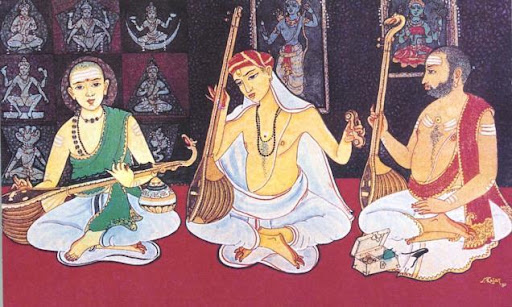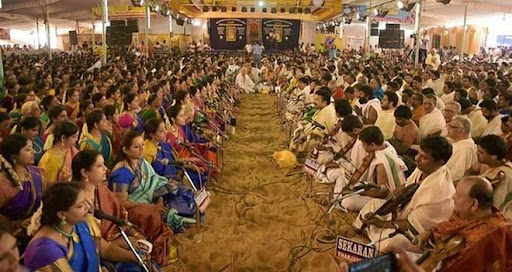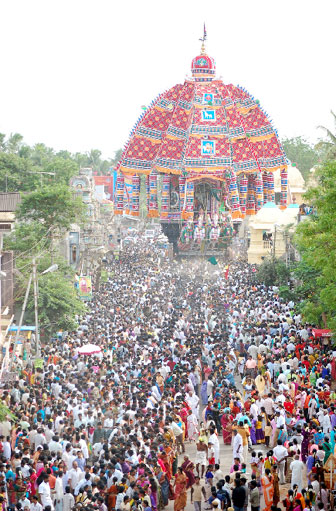Art, Culture and Festivals
ART AND CULTURE
The town was a traditional center of music and dance–the inscriptions from Rajaraja Chola associates a large body of dancers associated with the temple. There was large influx of the acumen of South Indian culture into Tiruvarur during the 17th century resulting in developments in music and dance. A unique musical instrument called Panchamuga Vadyam with each of its five ends ornamented differently is used in the temple. A type of nadaswaram (pipe instrument) called Pari Nadaswaram is also a unique instrument found only in Thiruvarur.
Historically Tiruvarur has been a center of eminent people in religion, arts and science. Inside the Subramanya Swami temple in Tiruvarur, there is an art gallery depicting the greatness of the judicious king Manuneethi Cholan.
The three Carnatic Music Saints and contemporaries – Tyagaraja, Shyama Shastri and Muthuswami Dikshatar were all born in Tiruvarur. This famous trinity of Carnatic music composed enduring devotionally inspired classics here. The Tyagaraja Carnatic Music Festival, in Tiruvarur is held here in January every year. It attracts legendary singers and large groups of music lovers from all across the country. The festival is to pay homage to Saint Tyagaraja and the songs sung as part of the homage are the “Pancharatna Kritis” or the Five Gems of Carnatic music composed by the Trinity.

The three Carnatic Saints Tyagarajar (middle), Muthuswami Dikshatar (right) and Shyama Shastri (left)

The famous Tyagaraja Aradhana festival
Tiruvarur Sung by the Poet Saints
Sundarar, an 8th-century Saivite saint, mentions “I am the slave of all those born in Thiruvarur” in his works in Tevaram. Two of the 63 nayanmars of Saivite tradition namely, Kalarsinga Nayanar and Tandiyadigal Nayanar were born in Thiruvarur. The Periyapuranam, a 12th century Saiva canonical by Sekkizhar, dedicates a chapter to those born in Thiruvarur including these two saints.
The Tiruvarur temple complex was extremely well known in the 6th century AD and had well developed, characteristic and esoteric traditions even at that time. A poem of Appar reveals that the temple traditions of Marghazhi Aathirai Vizha, Panguni Uttirai Perunaal, Veedhivitakanin Veedhi Panni, celebrated for Lord Tyagaraja and Neelotpalambal today, existed even before the 6th century A.D.
Poet Saint Appar (also called Tirunavukkarasar), one of the chief Nayanmars who are the 63 enlightened Saints devoted to Paramasiva, sang beautiful compositions on the Tyagaraja Swami temple during King Mahendra Pallava’s time in the 6th century AD. In his monumental work, “Thevaram”, Appar lovingly recalls the feats of Paramasiva with his people as the Lord of Tiruvarur. He addresses Paramasiva as Tyagesha because Paramasiva assumes the name Tyagarajan, the presiding deity of Tiruvarur.
Sekkizhar in his Periyapuranam describes the beauty of the mandapams of this temple in the story of Siruthonda Nayanar. The largest mandapam in the Tyagaraja Swami temple, the Deva Siriyam is one of the famous ancient monuments of Tamil Nadu. By virtue of being the site where the great poet Sundaramurthy Nayanar created his Thiruthonduthogai, its association with this benchmark in the religious-poetic history of Tamil Shaivism remains unforgotten. As a mandapam, the sheltered open space served as a stage for Koothu, a special form of a native theatre of Tamil Nadu that involved music, dance, and drama in an opera style setting and the more classic and codified form of dance, Bharathanatyam.
Festivals

Tiruvarur Chariot festival
Tiruvarur Chariot festival is a historical event that still follows the same rituals and traditions associated with the Thyagaraja Swamy temple of Tiruvarur. The Lord Veethividangar (வீதிவிடங்கர்) now called as Thiyagarajaswami (Shiva) comes out of the massive ancient temple, with his consort Kondi (கொண்டி) (Parvathi) to bless the devotees who always come to visit him in his abode, one of the world’s biggest chariots. The chariot, constructed by the Vishwakarma community, is a beautiful structure with intricate work and the biggest, which was used as the model for the Valluvar Kottam in Chennai. The original chariot was burnt in 1922 in an accident. The new chariot was later built and has replaced the old one in the original grandeur.
This ancient festival is often mentioned in the devotional hymns of saints like ( Appar, Tirugnanasambandar, and Sundarar) and many Tamil literary works. It is usually held during the summer between months of March and April every year and lasts more than 25 days. On the day of the chariot festival, the Utsava Moorthi (the deity who comes out for procession) is beautifully decorated and brought out of the temple along with his consort to the Great Chariot (in Tamil: ஆழித் தேர்) and go for the procession all day long. This chariot is said to the biggest one of its type in size and height. It is 96 feet (29 m) tall and weighs more than 300 tons. Apart from this grand chariot, there are 4 more for the lord’s consort, Subramanya, Ganapati, and Chandikeshwar respectively. All the chariots are large, but relatively smaller than the Great Thear of Tiruvarur. This grand Chariot is extensively decorated with wooden carvings and finishes. It requires a minimum of ten thousand people to pull the chariot around the four surrounding streets of the temple.
